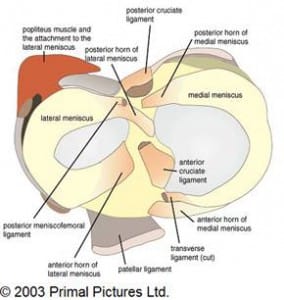CARTILAGE/MENISCUS TEAR
There are two meniscii in the knee, known as lateral and medial. The meniscii are roughly c-shaped and made up of very tough fibrocartilage. They are positioned between the tibia (shin bone) and femur (thigh bone) on the outer aspect of the joints.

The meniscii perform the following important functions in the knees:
• Improve load transmission – due to their shape, they are able to increase to contact area between the tibia and femur, so that forces can be transmitted over a larger area. Some research has shown that as much as half of the contact area is lost when a complete meniscectomy is performed, a procedure which involves the removal of a whole meniscus.
• Increase stability of the knee joint – the femoral condyles (ends of the thigh bones) and the tibial plateux (ends of the shin bones) are not perfect fits. The shape of the meniscii helps to form a deeper socket for the femoral condyles to fit into. They assist in both guiding and limiting the flexion (bending) and extending (straightening) of the joint.
• Improve shock absorption – the cartilage has a high water content and acts as a sponge, dampening compressive loads on the joint.
• Lubrication – the loading and unloading of the meniscii helps the movement of fluid around the inside of the joint and this fluid contains essential nutrients to maintain joint health.
• Proprioception (joint position sense) – the meniscii have small nerve sensors which work on a feedback type mechanism to help protect the joints from any dangerous positions.
The most common mechanism for damaging a meniscus is a compressive and twisting action with the knee flexed (bent) and the foot planted. This mechanism is not dissimilar to the ACL rupture and they may frequently occur at the same time.
SYMPTOMS
When a patient experiences an acute meniscus tear, they often describe pain, joint swelling (which may be rapid or slow, depending on the severity of the injury), locking/catching of the knee joint (in severe cases), giving way, tenderness (if medial meniscus, this may be on the inside part of the knee) and limited movement of the knee. There is often a mix of symptoms and, if the damage is more chronic in nature, such as arthritis and wear-and-tear, the symptoms can be quite mild.
Meniscus tears can often be diagnosed by MRI scans, although in some cases they are only picked up through arthroscopy (a keyhole procedure using a camera to look inside the joint).
The meniscus doesn’t have a good blood supply, with only the outer portion of the medial meniscus having blood vessels. This means it’s not very quick to heal when damaged – and may not heal at all. Patients are generally advised to rest and avoid any activities which involve twisting and compressing the joint, such as jumping and kicking. If the damage is severe or conservative care measures have failed, then an orthopaedic consultant opinion should be sought with a view to partial meniscectomy (shaving off the damaged cartilage via keyhole surgery) or a meniscus repair.
(The list of conditions given above and subsequent explanations are intended as a general guide and should not be considered a replacement for a full medical examination. Furthermore, we do not purport to treat all the conditions listed. Should you wish to discuss any of these conditions with our chiropractors, please do not hesitate to phone the clinic on 020 7374 2272 or email enquiries@body-motion.co.uk).
Our team of chiropractors and massage therapists are on hand to answer any questions you may have, so get in touch today via enquiries@body-motion.co.uk or on +44 (0)20 7374 2272.
Get Seen Today – Check Availability Now
